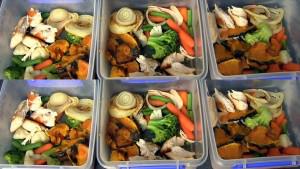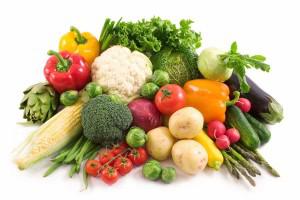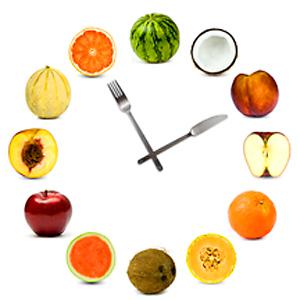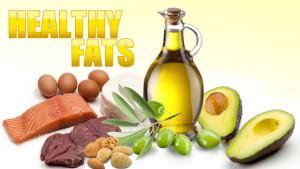The Guidelines
Study after study shows that giving someone an exact diet plan doesn’t work. There’s a couple of reasons for this. For starters, these one-size-fits-all programs generally leaves people more confused than ever. Our lives are dynamic and our diet plan needs to reflect that. Secondly, it doesn’t address the larger issue of why people fail on nutrition programs. While head knowledge is important, 80% of your results will come from behavior change, not new information. I’m gonna share an inside secret that may damage some egos of personal trainers and nutritionists everywhere. This stuff isn’t rocket science. The reality is if the average person followed the diet plan from a fitness magazine to the tee, they would probably get better results. Nobody does though.
I’m going to share with you the five Nutrition Success Principles we teach our personal training and nutrition clients. Are these the “be all end all?” Not necessarily, but let me illustrate how well they work. We recently started a nutrition accountability program we run called Answers where we coach our members to follow the guidelines. Here were the results.
*These are the actual #s in 5 short weeks! Nothing is changed to bloat the numbers.
Total participants – 11
Weight lost – 71 pounds
Inches lost – 15.75
Body fat lost – 19.08 lost
Wow! And these are regular folks just like you. Kids. Jobs. Mortgages. All the same stuff we all deal with.
There are no “secrets.” It’s really about just doing a little better each day. Which one of these guidelines do you think will make the biggest difference for you?
- Eat three regular sized meals or eat a smaller meal every 3-4 hours – We find that most people do better by eating smaller more frequent meals. It helps keep the metabolism stoked and prevents overeating. As long as the rest of the “rules” are adhered to, go nuts and eat every couple of hours. With that said, we are all different and if the traditional “3 squares” works for you then go for it.
- Consume some high quality protein with each meal – Some of our favorites are egg whites, lean beef, chicken breast, and a high quality protein shake. If you think this list is boooooring, don’t fret. There are plenty of options. How about shrimp, salmon, mahi-mahi, or tuna? If you’re a vegetarian, the rule still applies. You’ll just need to get “complimentary” proteins, which you can do by mixing certain non-animal sources.
- Consume fibrous veggies with each meal – In addition to protein you’ll need some veggies on your plate. Instead of providing a list, just think anything you’d put in a salad (Not croutons!).
- Eat according to what you’re doing – Think of carbohydrates like fuel to your car. Recent research shows that refined carbohydrates are the main culprits of some terrible systemic issues like diabetes and heart disease. This is an individual thing and figuring out your carb tolerance is like finding the right key to a unique lock. Generally carbs are tolerated well after exercise so this might be a good time to enjoy some non-fruit/veggie carbohydrates. See list below.
- Maintain a balance of healthy fat in your nutrition plan – Fat has been the most misunderstood nutrient in recent years. It’s even surpassed carbohydrates in that category. There are 3 types of fat and you should eat a balance of them – Saturated, monounsaturated, and polyunsaturated. Saturated fat generally comes from animal products. Monounsaturated fat comes from foods such as nuts and olives. For polyunsaturated fat, think flaxseed and fish oil. Believe it or not consuming healthy fat can help you lose fat.
Now judging by these guidelines you can easily tell if your meal is an effective one or not. No protein in your meal? Doesn’t qualify It violates Success Principle 1. No veggies? As you can see that defies Success Principle 3.
Follow the lists
Once you learn more you can get fancy but for now stick to consuming foods on the recommended lists. For your convenience, here are the lists. Feel free to print them before you go to the grocery store.
Protein
- Chicken breast (the real bird, not fast food meat!)
- Turkey breast (the real bird, not sliced lunch meat!)
- Game meats (venison, elk, etc.)
- Bison/buffalo (is often leaner than regular beef)
- Very lean red meat such as top round and lean sirloin (grass fed is especially nutritious)
- Almost all types of fish
- Salmon Shellfish and other seafood
- Eggs
- Dairy products
Fibrous veggies
- broccoli
- Asparagus
- Spinach
- Brussel Sprouts
- Green Beans
- Bell Peppers (green or red)
- Zucchini (summer squash)
- Lettuce and other salad greens (darker the better)
- Kale
- Cauliflower
- Cabbage
- Onions
- ALL other green and fibrous carbs
Starchy Carbs – Again these are only if you can tolerate the carbs/calories
- Sweet potatoes (or yams)
- White potatoes
- Brown rice
- Oatmeal (the natural, unsweetened kind!)
- Black eye peas
- lentils
- Squash
- Peas
- chick peas
- beans all kinds: black, pinto, navy, kidney, etc.
- Quinoa (a natural whole grain)
- 100% whole grain bread and pasta products (use in moderation – even though they are made with the whole grain, they are lightly processed and calorie dense)
Healthy fats
- Fatty fish (Wild Alaskan salmon, sardines, mackerel, trout
- Fish oil supplements
- flaxseeds (ground)
- flaxseed oil (as a supplement, not for cooking)
- extra virgin olive oil
- extra virgin coconut oil (for cooking; NOT hydrogenated varieties)
- walnuts
- Almonds
- other nuts
- seeds
- Avocados
- Olives
- Coconut oil
- Natural peanut butter or nut butters (NOT the sugar-sweetened kind)
What gets measured gets done
One of the reasons our Long Island boot camp members mentioned above did so well was because there was some built in accountability. . I love the quote, “What gets written down gets done.” It’s so true. If you want to make improvements in an area you must put your attention there. You have to track what you want to improve. Here are two phenomenal ways to track your-self in regards to nutrition.
Basic journaling – Basic journaling is great if you’re the type of person that gets all wound up about the numbers. Simply write down the following each day…..Time of day, what you consumed, how much, and one sentence regarding how you did overall. For example, a meal entry might look like this…”7AM – 3 eggs, 1 mini bagel, and banana.” With this method you can use a paper and pen (which is what I do) or just type it into your phone.
MyFItnessPal – Get the app and just track your total calories. Don’t worry about the exercise stuff,. . Just the total calories here. Here is the trick to losing weight. Take a week or two and find out your baseline amount of calories per day. Get the average by dividing the total number of days (e.g. 7 or 14 days)into the total calories (e.g. 14,000 or 28,000). If you lost weight or body fat, you are probably on the right track. If you stayed the same then this is the amount you need to maintain your weight. If you gained then you know what that means! Keep in mind the calorie deficit only needs to be slight. For example, 10% should do the tick. So if you are eating 2000 calories you’ll drop down to 1800.
 Get Accountability – We find accountability to be one of the most overlooked component to a fitness program. We all need a little kick in the pants every now and again. We can’t always do it on our own. Here are some ideas on getting accountability.
Get Accountability – We find accountability to be one of the most overlooked component to a fitness program. We all need a little kick in the pants every now and again. We can’t always do it on our own. Here are some ideas on getting accountability.
- Hire a coach
- Tell people you trust about your goals and ask them to hold you accountable
- Share your goals on social media so you will be more likely to follow through
Are carbs bad?
I’m glad you asked. Carbs are a very misunderstood nutrient. In fact, they fight with fat for being the most misunderstood.
I learned more about carbohydrates in this last year than I have in my entire 20 year (almost) career.
To make a long story short, I was away on a business trip when my doctor’s office called to notify me that I had diabetes. WHAT! How could this be? I’ve always been so healthy.
Well after going through the typical stages of emotion, I finally accepted this “reality” and began reading books and consulting with experts on low carbohydrate living as well as diabetes .
The good news is that I ultimately learned that my diagnosis was a mistake. They mixed up my lab report with someone else’s.
I now consider it a blessing in disguise because I gained a new perspective. It also allowed me to help our clients lose hundreds of pounds as well as help some folks get off of their meds. That’s what it’s all about for me, helping others experience a positive change.
Here is the long and short of it.
- We are all different and need a unique program
- Stabilizing your blood sugar by limiting intake of refined carbohydrates will assist you in fat burning
- While certain carbohydrates should probably be avoided, these veggies contain phytochemicals and help prevent cancer…. kale, broccoli, and cauliflower.
- If you tend to gain fat in the stomach area you may be more sensitive to carbohydrates. If you gain more in the hips then you may be able to tolerate them better.
- As a general rule, move more and eat according to what you’re doing and you can’t go wrong.
Since one of our values at our Long Island Boot Camp is Going the Extra Mile, here some extra tips!
- Sometimes the best way to assess yourself is with the mirror
- Eating the right foods will boost your metabolism
- Increasing muscle will result in additional fat loss
- Eat slowly
- Here are no magic pills or surgeries or injections
- You need to eat plenty of real whole food
- Slimming spices – cinnamon stabilizes blood sugar levels, cayenne (hot sauces) boosts metabolic rate
- Green tea increases metabolic rate
- Keep these out – They have obesogens – pesticides on produce, BPA in cans, non-stick pans
- Poop once per day ( I know that’s gross 🙂 )
- Drink plenty of water
- Get plenty of fiber
- LOVE your body!
To sum things up, here is your checklist of things you need to do.
- – Decide you are ready for a change and act on that. Do NOT wait. If you wait you may be setting yourself back 6 months or longer! There is never a perfect time. Act now!
- – Get some initial data to you know where you’re starting from. This could be as simple as body weight or you can also get a baseline for calorie consumption as mentioned above.
- – Start tracking yourself by recording daily. Do NOT become obsessed with the scale weight. You just want to use it as a guide. Do the right things and the right things will happen.
- – Shop for the heathy food on the lists provided so you can prepare some healthy meals.
- – Get an accountability plan in place on your own or hire a coach.
It might be hard to believe that this simple plan is all it takes to lose weight. I’m telling you it is. There is so much info out there that we tend to over complicate things. Commit to these steps, follow through, and you will succeed.
Billy Hofacker B.S., CSCS, FMS LEVEL 1
Click Here to Learn more about Billy H




